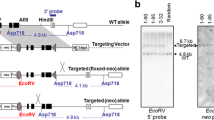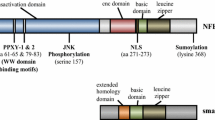Abstract
NFKB2 is a member of the NFKB/Rel gene family, which is known to be a pivotal regulator of the acute phase and immune responses. NF-κB2 is initially synthesized as a ∼100 000 M r protein which needs to be processed in order to bind DNA, either as homodimer or as heterodimer with other members of the NF-κB/Rel family. The unprocessed form of NF-κB2 acts as an IκB-like protein. Therefore, NF-κB2 has a dual function. In this report we describe the genomic structure, expression pattern, and chromosomal localization of mouse NFKB2. Genomic clones were isolated, which span the entire gene of approximately 8.5 kilobases (kb) including 1.5 kb of the promoter region. Comparison to its human and avian homologues revealed a strong evolutionary conservation of the gene structure including the exon/intron borders, sequence, and position of the nuclear localization signal, the glycine-hinge region, and the ankyrin repeats. By fluorescence in situ hybridization, mouse NFKB2 was mapped to Chromosome (Chr) MMU 19C3-D2, which is homologous to human Chr 10q24, at which position the human NFKB2 was previously located. NFKB2 is ubiquitously expressed, highest in lymph nodes and thymus, underlining its role in the immune function.
Similar content being viewed by others
Author information
Authors and Affiliations
Additional information
Received: 14 January 1999 / Revised: 29 March 1999
Rights and permissions
About this article
Cite this article
Paxian, S., Liptay, S., Adler, G. et al. Genomic organization and chromosomal mapping of mouse nuclear factor kappa B 2 (NFKB2). Immunogenetics 49, 743–750 (1999). https://doi.org/10.1007/s002510050548
Issue Date:
DOI: https://doi.org/10.1007/s002510050548




